References
[1]. Kanacri, B. P. L., Pastorelli, C., Eisenberg, N., Zuffianò, A., Castellani, V., & Caprara, G. V. (2014). Trajectories of prosocial behavior from adolescence to early adulthood: Associations with personality change.Journal of Adolescence, 37(5), 701–713.
[2]. Lazarus, R. S., & Folkman, S. (1984). Stress, appraisal, and coping. Springer Publishing Company.
[3]. Gross, J. J. (1998). The emerging field of emotion regulation: An integrative review.Review of General Psychology, 2(3), 271-299.
[4]. Ochsner, K. N., & Gross, J. J. (2005). The cognitive control of emotion.Trends in Cognitive Sciences, 9(5), 242–249.
[5]. Wang, D., Yuan, B., Han, H., & Wang, C. (2022). Validity and reliability of emotion regulation questionnaire (ERQ) in Chinese rural-to-urban migrant adolescents and young adults.Current Psychology, 41(4), 2346–2353.
[6]. Fong, W., Rockett, R. J., Tam, K. K.-G., Nguyen, T., Sim, E. M., Tay, E., ... Watt, A. E. (2024). Targeted culture-independent sequencing identifies the emergence of macrolide-resistant Bordetella pertussis in Australia. medRxiv. https: //doi.org/10.1101/2024.12.19.24319368
[7]. Baudin, J. S. P., & Chavez, M. L. L. (2025). A narrative inquiry into self-discovery, social, and emotional development among young adults through cosplay.International Journal of Social Science and Education Research Studies,5(1), 58-69
[8]. Tajfel, H., & Turner, J. (2004). The social identity theory of intergroup behavior. In J. T. Jost & J. Sidanius (Eds.),Political psychology: Key readings(pp. 276–293). Psychology Press.
[9]. Snodgrass, J. G., Lacy, M. G., Dengah II, H. F., Eisenhauer, S., Batchelder, G., & Cookson, R. J. (2014). A vacation from your mind: Problematic online gaming is a stress response.Computers in Human Behavior, 38, 248–260.
[10]. Przybylski, A. K., & Weinstein, N. (2017). A large-scale test of the Goldilocks hypothesis: Quantifying the relations between digital-screen use and the mental well-being of adolescents.Psychological Science,28(2), 204–215.
[11]. Festinger, L. (1957). Social comparison theory.Selective Exposure Theory, 16(401), 3.
[12]. Turner, J. C., & Oakes, P. J. (1986). The significance of the social identity concept for social psychology with reference to individualism, interactionism and social influence.British Journal of Social Psychology, 25(3), 237–252.
[13]. Kowert, R., Domahidi, E., Festl, R., & Quandt, T. (2014). Social gaming, lonely life? The impact of digital game play on adolescents’ social circles.Computers in Human Behavior, 36, 385–390.
[14]. Jenkins, H. (2018). Fandom, negotiation, and participatory culture.In A companion to media fandom and fan studies(pp. 11–26).
[15]. Aldao, A., Nolen-Hoeksema, S., & Schweizer, S. (2010). Emotion-regulation strategies across psychopathology: A meta-analytic review.Clinical Psychology Review, 30(2), 217–237.
[16]. Gross, J. J., & John, O. P. (2003). Individual differences in two emotion regulation processes: Implications for affect, relationships, and well-being.Journal of Personality and Social Psychology, 85(2), 348–362.
[17]. Zhao, J., Mo, L., Bi, R., He, Z., Chen, Y., Xu, F., ... Zhang, D. (2021). The VLPFC versus the DLPFC in downregulating social pain using reappraisal and distraction strategies.Journal of Neuroscience, 41(6), 1331–1339.
[18]. Suthana, N., Ekstrom, A. D., Yassa, M. A., & Stark, C. (2021). Pattern separation in the human hippocampus: Response to Quiroga. Trends inCognitive Sciences, 25(6), 423–424.
[19]. Tang, J., LeBel, A., Jain, S., & Huth, A. G. (2023). Semantic reconstruction of continuous language from non-invasive brain recordings.Nature Neuroscience, 26(5), 858–866.
[20]. Rubin, K. H., Coplan, R. J., & Bowker, J. C. (2009). Social withdrawal in childhood.Annual Review of Psychology, 60(1), 141–171.
[21]. Jetten, J., Haslam, C., & Alexander, S. H. (2012). The social cure: Identity, health and well-being. Psychology Press.
[22]. Al-Shawaf, L., Conroy-Beam, D., Asao, K., & Buss, D. M. (2016). Human emotions: An evolutionary psychological perspective.Emotion Review, 8(2), 173–186.
[23]. Cavicchi, D. (2018). Foundational discourses of fandom.In A companion to media fandom and fan studies(pp. 27–46).
[24]. Grandey, A. A. (2000). Emotional regulation in the workplace: A new way to conceptualize emotional labor.Journal of Occupational Health Psychology, 5(1), 95–110.
[25]. Brotheridge, C. M., & Grandey, A. A. (2002). Emotional labor and burnout: Comparing two perspectives of "people work."Journal of Vocational Behavior, 60(1), 17–39.
[26]. He, Z., Muhlert, N., & Elliott, R. (2021). Emotion regulation of social exclusion: A cross-cultural study.Humanities and Social Sciences Communications, 8(1), 1–7.
[27]. Kross, E., & Ayduk, O. (2017). Self-distancing: Theory, research, and current directions.In Advances in experimental social psychology(Vol. 55, pp. 81–136). Elsevier.
[28]. Lorenz-Spreen, P., Lewandowsky, S., Sunstein, C. R., & Hertwig, R. (2020). How behavioural sciences can promote truth, autonomy and democratic discourse online.Nature Human Behaviour, 4(11), 1102–1109.



